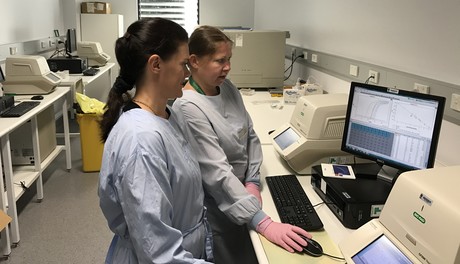Australian-developed risk scoring system predicts childhood leukaemia relapse

Australian researchers have developed a new risk scoring system for children with leukaemia based on missing DNA fragments or ‘microdeletions’.
The international study, led by Australian researchers at Children’s Cancer Institute, discovered that searching for specific gene microdeletions found only in leukaemia, when combined with two other test results, provides doctors with a more accurate way to categorise patient risk than the current approach. The findings were published in the British Journal of Haematology.
The study tested 475 patients from 6 different children’s hospitals in Australia and New Zealand enrolled on a clinical trial sponsored by ANZCHOG, the Australian and New Zealand Children’s Haematology and Oncology Group.
The patients were all children with non-high-risk B-cell precursor acute lymphoblastic leukaemia (BCP-ALL), a subtype of acute lymphoblastic leukaemia (ALL), the most common childhood cancer with survival rates typically near 90%. Most children with ALL have B-cell precursor acute lymphoblastic leukaemia. Study leader Associate Professor Rosemary Sutton said the most intensive treatment for BCP-ALL patients was usually given to the 11% or so of children in the high-risk category to limit side effects for kids who don’t need it.
“Children in the standard and medium risk category in the study were given less intensive treatment than high-risk patients. But about one in six of them relapsed. Obviously, some children needed more intensive treatment than previously thought — but which ones?” she said.
The scoring system, developed by Sutton and collaborators, builds on a bone marrow test, the minimal residual disease or MRD test developed at Children’s Cancer Institute, which gives doctors early warning that treatment may not be working. The MRD test is so sensitive it can detect just one cancer cell in a million bone marrow cells surviving cancer treatment. The test was a huge boon for some children with leukaemia on this same trial, since it alerted doctors that they had a very high risk of relapsing. Consequently, they were treated very intensively with chemotherapy and bone marrow transplants, and the survival rate of this subgroup doubled. But MRD alone is not enough.
“For the standard to medium risk group, we needed more information to get a better handle on the biology of the child’s cancer to better determine their risk,” said Sutton.
“So, we supplemented MRD results with two other pieces of patient information, the presence or absence of specific gene microdeletions and a score called the NCI (National Cancer Institute) risk, based on age and white blood cell count.
“We tested for microdeletions in nine genes involved in leukaemia and found that two of the genes, IKZF1 (called ‘Ikaros’) and P2RY8-CRLF2, were important predictors of relapse,” she said.
These measures were combined to calculate a risk score for each patient of ‘0’ (no risk factors) to ‘2+’ (several). The study found that children with a ‘2+’ score were most likely to relapse or die within seven years after treatment started, while those with a ‘0’ score least likely.
The same microdeletions were found to be important for predicting relapse in a cohort of Dutch children with leukaemia and the new scoring system was validated by researchers in The Netherlands.
If the new risk score system is adopted in future, doctors could give children with a ‘2+’ risk more intensive treatment with the aim of improving their survival.
Dr Toby Trahair, paper co-author and oncologist at Kids’ Cancer Centre at Sydney Children’s Hospital, Randwick, said the scoring system could make a big difference to the success of childhood leukaemia treatment.
The study included researchers from Children’s Cancer Institute, UNSW, The Children’s Hospital at Westmead, Women’s and Children’s Hospital in Adelaide, John Hunter Hospital in Newcastle and Sydney Children’s Hospital, Randwick, as well as researchers in The Netherlands and Germany.
European Space Agency inaugurates deep space antenna in WA
The ESA has expanded its capability to communicate with scientific, exploration and space safety...
Black hole collision supports Hawking's landmark theory
Astrophysicists have witnessed a collision between two black holes that was so loud, they were...
Uncovering differences in wild and domesticated crops
Researchers have revealed insights into the genetic make-up of wild varieties of common crops...



